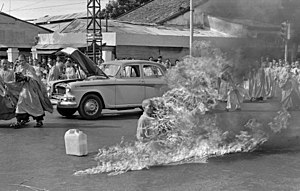
Back الأزمة البوذية Arabic Buddist böhranı Azerbaijani Yr argyfwng Bwdhaidd Welsh Buddhistenkrise German Budhana krizo Esperanto Incidente budista en 1963 Spanish Buddhalainen kriisi Finnish Crise bouddhiste French Krisis Buddhis ID Crisi buddista del Vietnam Italian
| Buddhist crisis | |||
|---|---|---|---|
| Part of the Vietnam War | |||
 Thích Quảng Đức's self-immolation | |||
| Date | 8 May – 2 November 1963 (5 months, 3 weeks and 4 days) | ||
| Location | |||
| Resulted in |
| ||
| Parties | |||
| Lead figures | |||
| Casualties and losses | |||
| |||
The Buddhist crisis (Vietnamese: Biến cố Phật giáo) was a period of political and religious tension in South Vietnam between May and November 1963, characterized by a series of repressive acts by the South Vietnamese government and a campaign of civil resistance, led mainly by Buddhist monks.[1]
The crisis was precipitated by the shootings of nine unarmed civilians on May 8 in the central city of Huế who were protesting against a ban of the Buddhist flag. The crisis ended with a coup in November 1963 by the Army of the Republic of Vietnam (ARVN), and the arrest and assassination of President Ngô Đình Diệm on November 2, 1963.
- ^ Adam Roberts, 'Buddhism and Politics in South Vietnam', The World Today, Royal Institute of International Affairs, London, vol. 21, no. 6, June 1965, pp. 240–50 analyses the causes of the Buddhist crisis and its significance as a case of non-violent struggle.
© MMXXIII Rich X Search. We shall prevail. All rights reserved. Rich X Search